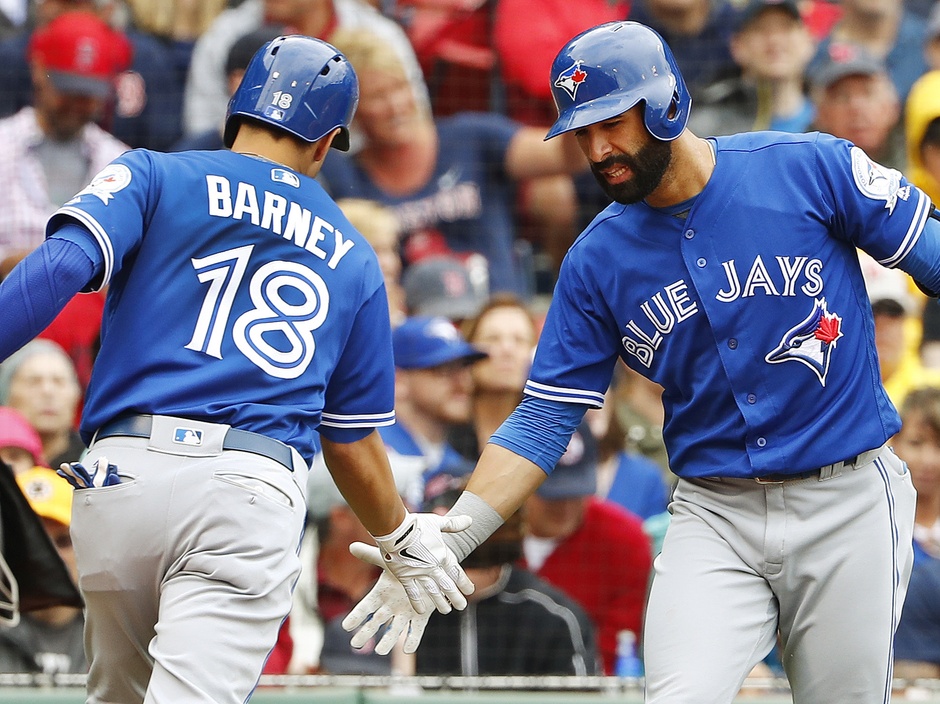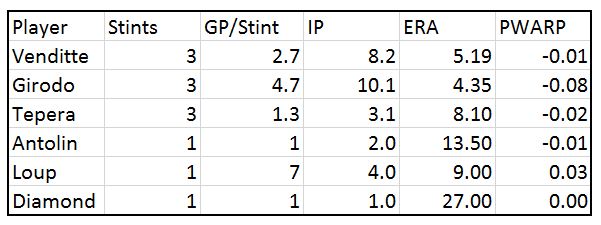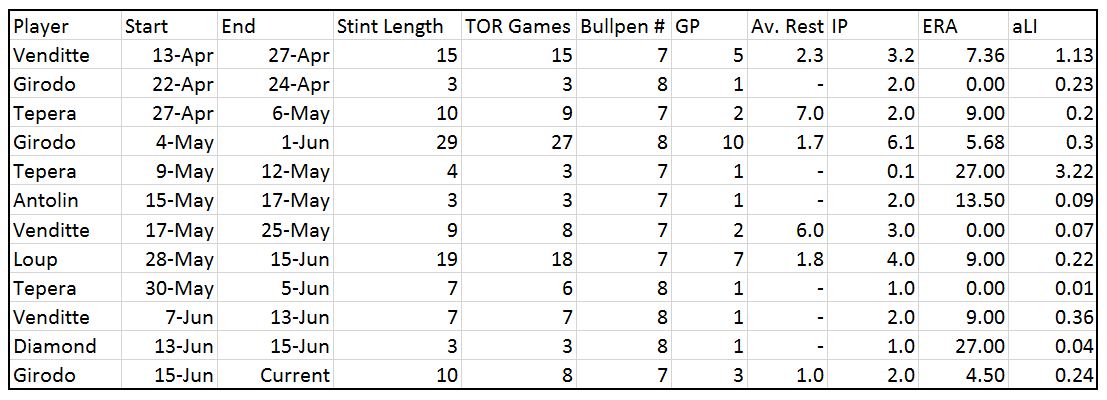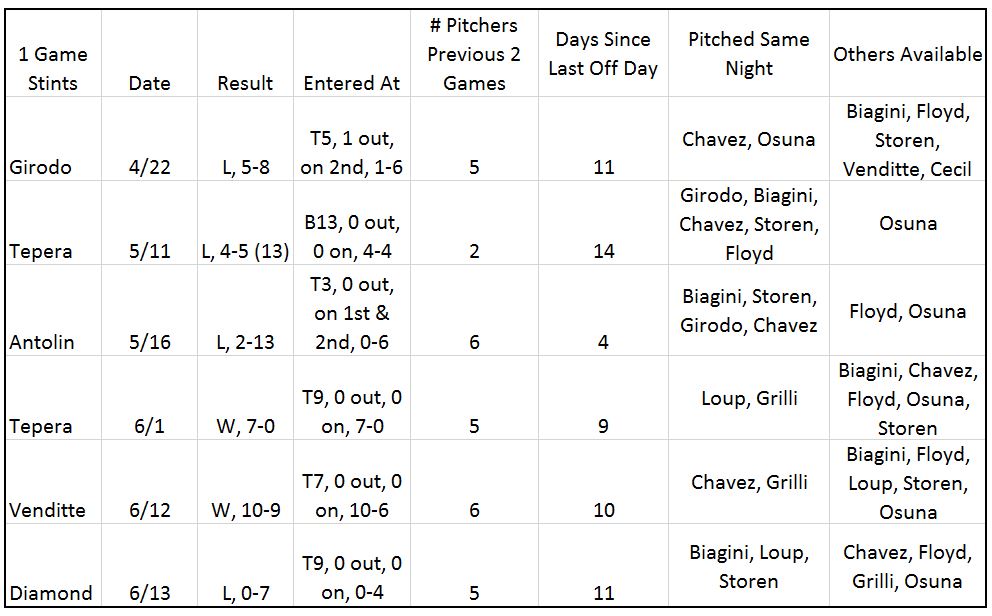Toronto’s recent series against the Philadelphia Phillies saw the appearance of a familiar face: Jimmy Paredes. The Blue Jays claimed Paredes off waivers from the Orioles on May 16, only to designate him for assignment on the 30th and ship him to Philadelphia on June 1st. After notching a .886 OPS in his 17 Blue Jay at bats, Paredes was traded for cash considerations. When Paredes stepped to the plate, Pat Tabler lamented that the team had to let him go and referred to the notion that the Jays ‘just didn’t have room for him.’
With apologies to Mr. Tabler, that’s a statement that didn’t quite sit well at first. It seems like the Blue Jays often have a frustratingly short bench and a bullpen that has one guy who never gets enough work in. While that makes for simple math, it’s something I wanted to investigate. Who have the Jays been using in their final roster spot and were their performances more valuable than Paredes’ admittedly short stint of production?
On the offensive side of the equation Paredes seemed to fill a need for the Jays, who could probably use a bench bat considering the current options, regardless of how adequately some of those players have performed so far. With a usual bench of Josh Thole, Ryan Goins, Darwin Barney, and Ezequiel Carrera (now Darrell Ceciliani), pinch hitting late in games seems futile beyond the instances where Edwin Encarnacion starts at first base and pushes Justin Smoak to the bench.
A jack of all trades and a master of none, Paredes can play around the infield as well as in the outfield but is generally a subpar defender no matter where you put him. His defensive deficiencies definitely didn’t help his case, but the team can probably afford to carry a bad defender who will be limited to mostly pinch hitting duties. If you were to pinch hit for, say Darwin Barney, you could get Paredes an at bat and then insert Ryan Goins (or more likely Devon Travis, assuming full health) into the game defensively.
Since the team is insistent on carrying four middle infielders when at full health, we can assume that the final bench spot was sacrificed so the team could add another reliever to the mix. Looking at this season’s end-of-bench hitters (chronologically by call-up date) shows just three players who haven’t performed well in limited at bats, Paredes excepted:
It’s unfair to ask anyone to try and hit major league pitching right away, especially when they’re given less than one plate appearance for each day spent with the big club. Additionally, the recent AAA assignment of Andy Burns marked the first time this season that a position player was not sent down to bring up a pitcher, as the activated Troy Tulowitzki took Burns’ spot on the roster. It’s clear that the Jays view Dominguez and Burns as insurance policies more than anything and getting them at bats is not one of the team’s primary goals. While it’s nice to have guys who can step in in case of injury, the Blue Jays could attempt to maximize their bench output in the meantime by having a legitimate pinch hitting threat.
With that in mind it’s pretty obvious that the team likes to call on relievers more often than not. The Jays typically run a seven man bullpen but will occasionally carry eight relievers, much to the chagrin of some fans, myself obviously included. When the team brings up an eighth reliever, there is usually simple logic to follow that rationalizes the move. They could be trying to bring up additional arms to get their usual guys some extra rest. They could be calling up certain pitchers for matchup purposes; like if a lefty heavy lineup is on the horizon. And finally, if the bullpen’s current members aren’t up to snuff, they could simply be trying a new solution.
The strong performance of Toronto’s rotation points to conflicting notions about the rest idea. The starters are more often than not only leaving 6-9 outs for the bullpen to record, which is good for the collective bullpen but probably puts undue stress on the top relievers. While the Jays would like to ease the burden on their trusted arms, no single reliever should be too overworked. Given the general mediocrity (though thankfully upward trend) of most of the Blue Jay relievers, the final spot has also served as a revolving door for different pitchers to show that they can stick with the big club.
The list of names hasn’t been all that inspiring, but having an effective mop up guy could pay off later. Everyone would take one step up the ladder, so pitchers like Jesse Chavez and Gavin Floyd will handle fewer low leverage innings and are better rested for situations that call for quality pitchers. In essence, a quality 7th reliever takes away an inning that would otherwise be wasted on superior pitchers. Given Roberto Osuna’s nagging ailments this year, the team has to be aching for some extra depth to both save arms and elevate top performers. So how have those alternatives looked?
As you can see, the results have been underwhelming so far. Rather than look at the season as a whole, I broke down each reliever’s numbers by their specific stretch with the Blue Jays.
On the whole, the last reliever on the roster is used in low leverage situations (by aLI), with the only exception being Ryan Tepera’s shrimp game in San Francisco. Even then, John Gibbons only called on Tepera because every other pitcher had been used aside from Roberto Osuna, who had pitched the previous two games. That low leverage use is ideal and accomplishes the goals outlined above concerning resting superior pitchers in less important situations, but it does raise the question of whether this rotating cast of characters is worth keeping over an extra bench bat considering they pitch so infrequently.
Aside from extended and ongoing stints by Chad Girodo and Aaron Loup’s 19 days on the roster, the bullpen call-ups might appear once per series. Tepera and Pat Venditte both had more than six days off at one point or another, and if the team really wants to give their high leverage guys an inning off every once in a while they certainly would be using these bottom bullpen players more often. So for the longer stints (we’ll deal with the one game guys in a moment), just how long do these pitchers get to show their stuff?
The average stint is just shy of 10 days, and shrinks to just over eight when we remove Girodo’s abnormally long outlier stint. If we also remove Aaron Loup’s run on the roster, operating under the assumption that he was expected to be a permanent member of the bullpen, it drops to just over seven days. These relievers spend about a week with the Jays and appear once or twice.
As for the pitchers who only made one appearance, they have all been used fairly ideally with the exception of Tepera’s necessary involvement in San Francisco:
Most of them took the mound in mop up duty during long stretches without an off day. If you want to give someone a chance to get work in, that’s the time to do it. For context, I looked at the amount of unique pitchers that Gibbons had called on over the previous two games. Two games was chosen as the cutoff simply because Gibbons often won’t use a pitcher on three consecutive nights. Aside from Tepera’s 13th inning outing, each other appearance came after five or six pitchers had seen action in the last two days. Beyond that, most of these damage control outings helped save a handful of more valuable pitchers from wasting innings in games that were all but over.
To sum it up, given the infrequent usage of the seventh man of the bullpen, there is almost never a reason to summon an eighth pitcher from Buffalo. That final spot would almost always be better spent on an extra bench bat. While having a player like Paredes around doesn’t guarantee John Gibbons would find him playing time, it seems like the last bullpen option has fewer opportunities to make an impact on the game. If anything, having both Barney and Goins on the roster makes having a pinch hitting specialist all the more palatable, especially late in games.
The team has actually done well to take a look at a few different pitchers this season in a Seventh Man role and while none have stuck so far, the Jays at least have an idea of what they’re working with. It might behoove the team to just give the spot to Loup, Girodo or Venditte and let them run with it in regular work, but there’s no harm in trying to get different pitchers acclimated to major league hitters in low leverage innings, especially earlier in the year. The negatives only truly arise when two spots are spent on players who appear infrequently at the expense of potential offensive upgrades. While the Blue Jays have tended to favor the safety net of a big bullpen, it might be time to think about the opportunity cost of doing so.
Lead Photos: Winslow Townson-USA TODAY Sports





This is interesting, but it would be more so if it wasn’t limited to just the Jays. In isolation, it does seem as if they could make better use of the 25th slot, but without looking at other teams, I don’t have any real sense of (a) how realistic it is to think they could have used the slot better, (b) how much more or less they’ve gotten from the slot relative to other teams, or (c) the degree to which the Jays’ usage of this slot is a problem that’s addressable in practice.